The 2024/25 Ligue 1 season is the first since 2019/20 that RC Lens have begun without Franck Haise at the helm.
After a stellar period of about four-and-a-half seasons or so at Stade Bollaert-Delelis, during which time he guided Les Sang et Or to as high as a second-place finish in France’s top-flight, which they achieved in 2022/23, Haise departed at the end of last season, deeming it time for a fresh start at OGC Nice.
His replacement in Pas-de-Calais would be none other than Will Still, the now-32-year-old coach who drew a lot of attention during his time as manager of Stade Reims in Ligue 1 from October 2022 to May 2024.
Still’s reign as Lens boss has begun positively, with the club currently sitting in sixth place at the time of writing this piece after playing seven games — two of which they’ve won and five of which they’ve drawn.
Lens remain one of only three unbeaten teams in France’s top flight at this point in the season, sharing that honour with the top two — league leaders AS Monaco and second-placed PSG.
Additionally, Lens have the joint-best defensive record in France’s top flight at this stage of the campaign, having conceded just four goals in their opening seven games.
They’ve also conceded the third-fewest expected goals (xG) (6.63) so far, on top of having the third-lowest xG per shot against at 0.095 — pretty encouraging defensive statistics.
To add to the above, none of Lens’ four goals conceded have come from open play, with two coming from corner kicks and two resulting from penalties.
So, it’s relatively safe to say Still’s side are one of Ligue 1’s most formidable forces in defensive terms at the beginning of 2024/25.
This tactical analysis piece and team-focused scout report provides some analysis of Lens’ defensive tactics at the beginning of the 2024/25 season under Will Still’s leadership.
We’re going to focus mainly on their performances in the mid-block phase of defence, their usage of the wide centre-backs which exist in their formation as a result of their use of the 3-4-1-2/5-2-1-2 shape and their central midfielders’ defensive roles within this currently-thriving tactical setup.
Lens’ Central Midfielders
To start, we’ll provide some analysis of what to expect from Lens’ central midfielders in the defensive phases.
Lens have been one of Ligue 1’s most aggressive sides without the ball in 2024/25, with a PPDA of 8.0 putting them second-lowest, only behind Monaco, in that particular metric at the time of writing — a solid indication of high pressing intensity as is their high ‘challenge intensity’ of 6.1 — third-highest in France’s top-flight so far.
They tend to press aggressively from the mid-block, with their central midfielders often getting dragged quite high and/or out of position, following players who’d previously entered their zones.
Lens do use a zonal marking system, but the central midfielders are prone to getting dragged away in a man-oriented fashion once they pick up a player who’d entered their zone unless they’ve safely passed the player off to another teammate.
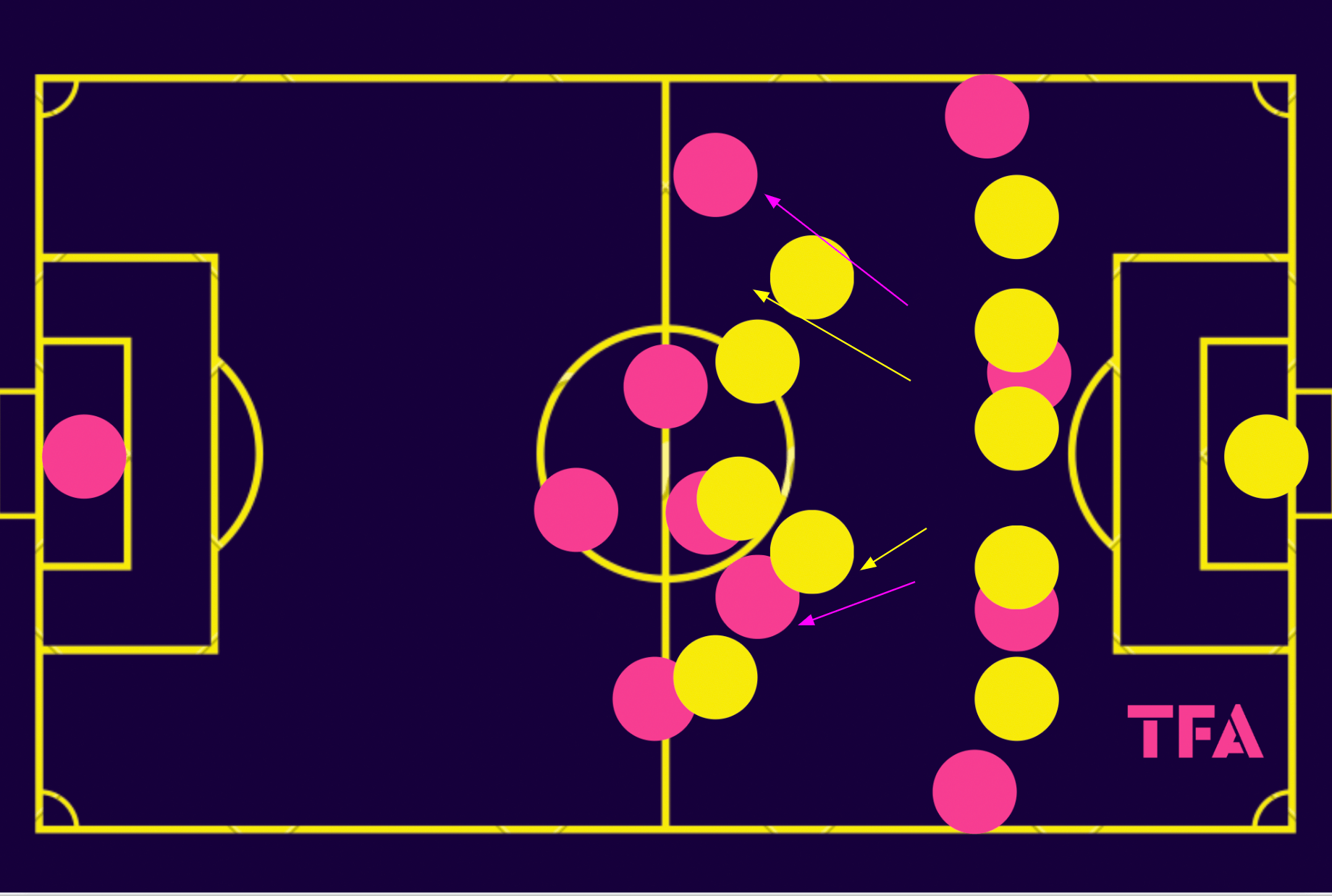
This was the case in the game from which this example was taken—their 0-0 Ligue 1 draw with Lyon on September 15th.
As both central midfielders got a bit fixated on their man, with no teammate appearing to pass them off safely, a fairly large amount of space opened up in front of Lens’ backline, which an opposition player could move into and exploit with some intelligent off-the-ball movement.
Lens’ Wide Centre-Backs
Lens always start with three centre-backs, and the wider two will typically play far more aggressively than the central centre-back.
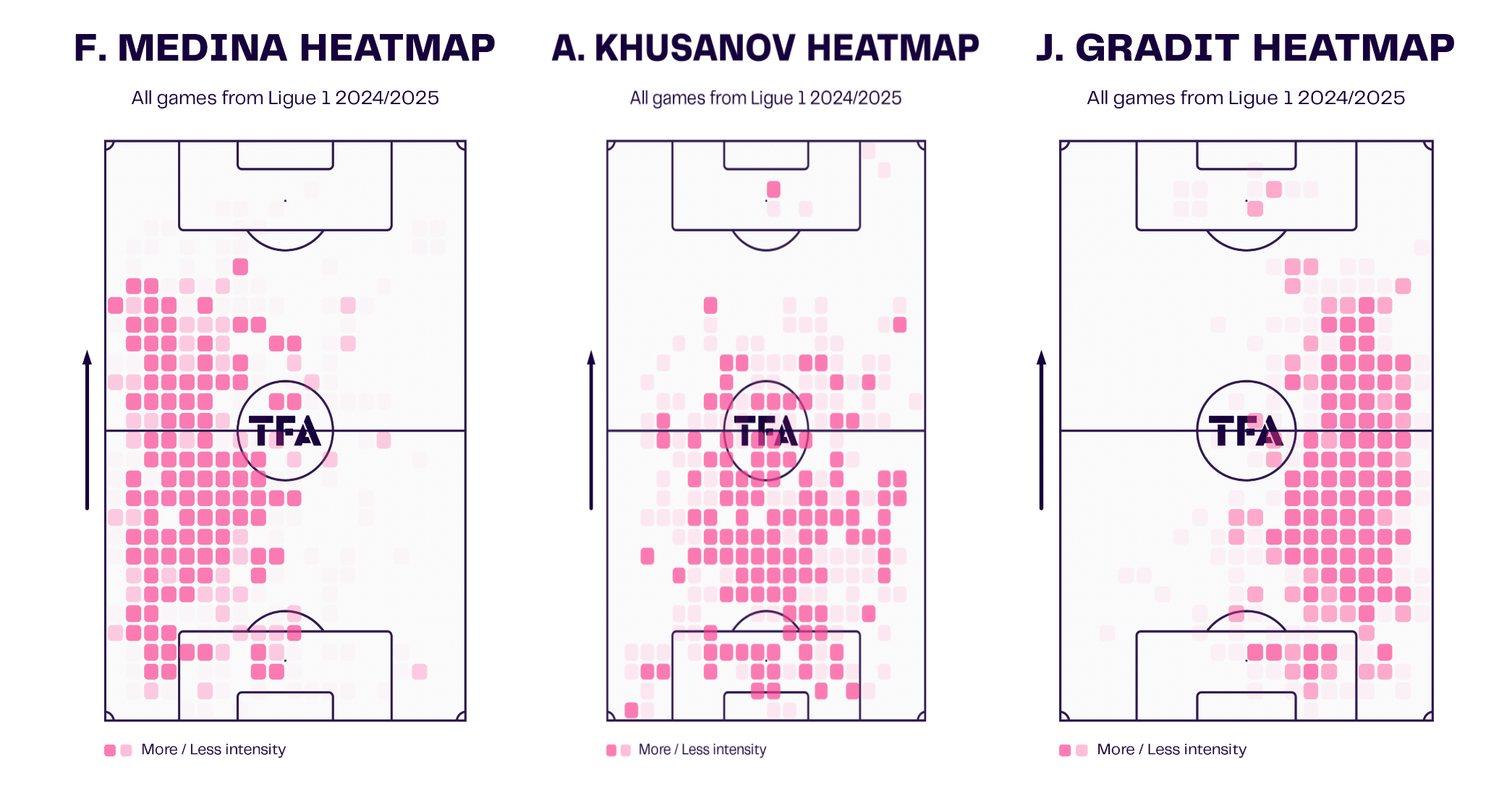
Indeed, the wide centre-backs will step out and carry the ball forward in possession a bit more than Khusanov, but they’ll also step out and engage attackers defensively more often.
Figure 1 of the previous section provides a good context for when and why that’d be the case.
As Lens’ central midfielders get dragged out of position, it opens up space in front of Lens’ backline that could be exploited.
The wide centre-backs are alert to this potential danger and will look to guard that space by stepping out from the backline aggressively to protect that area.
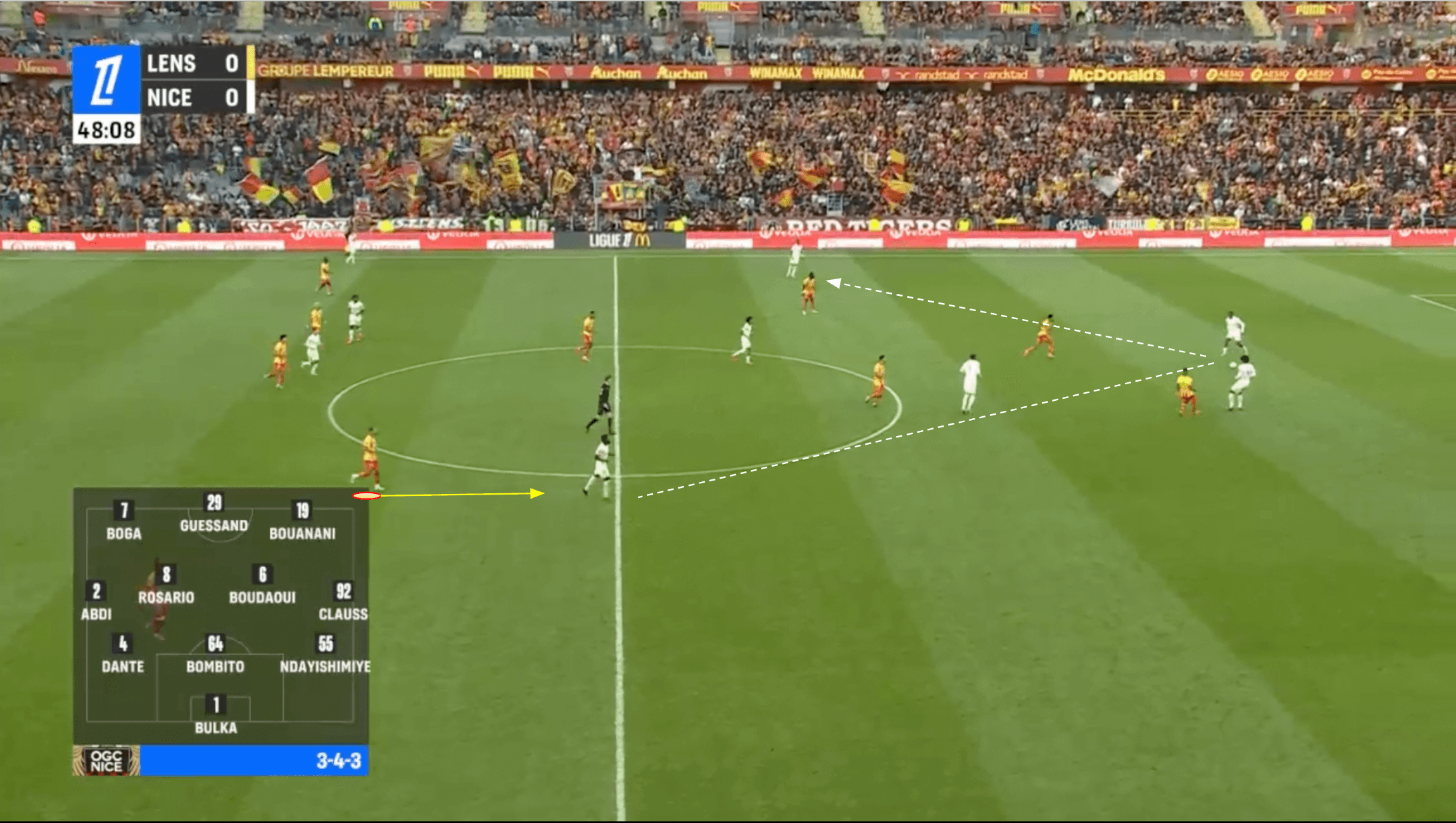
Here, versus Nice, an opposing player has dropped off into the half-space where they’ve found some room behind the central midfielder who’s been dragged high.
As a passing lane opens up between the deep ball carrier and this potential receiver, Gradit steps out of the backline to get close to that attacker and make the passing option less appealing.
As play moves on, the Nice centre-back ultimately moves the ball out to the opposite wing via his right-back.
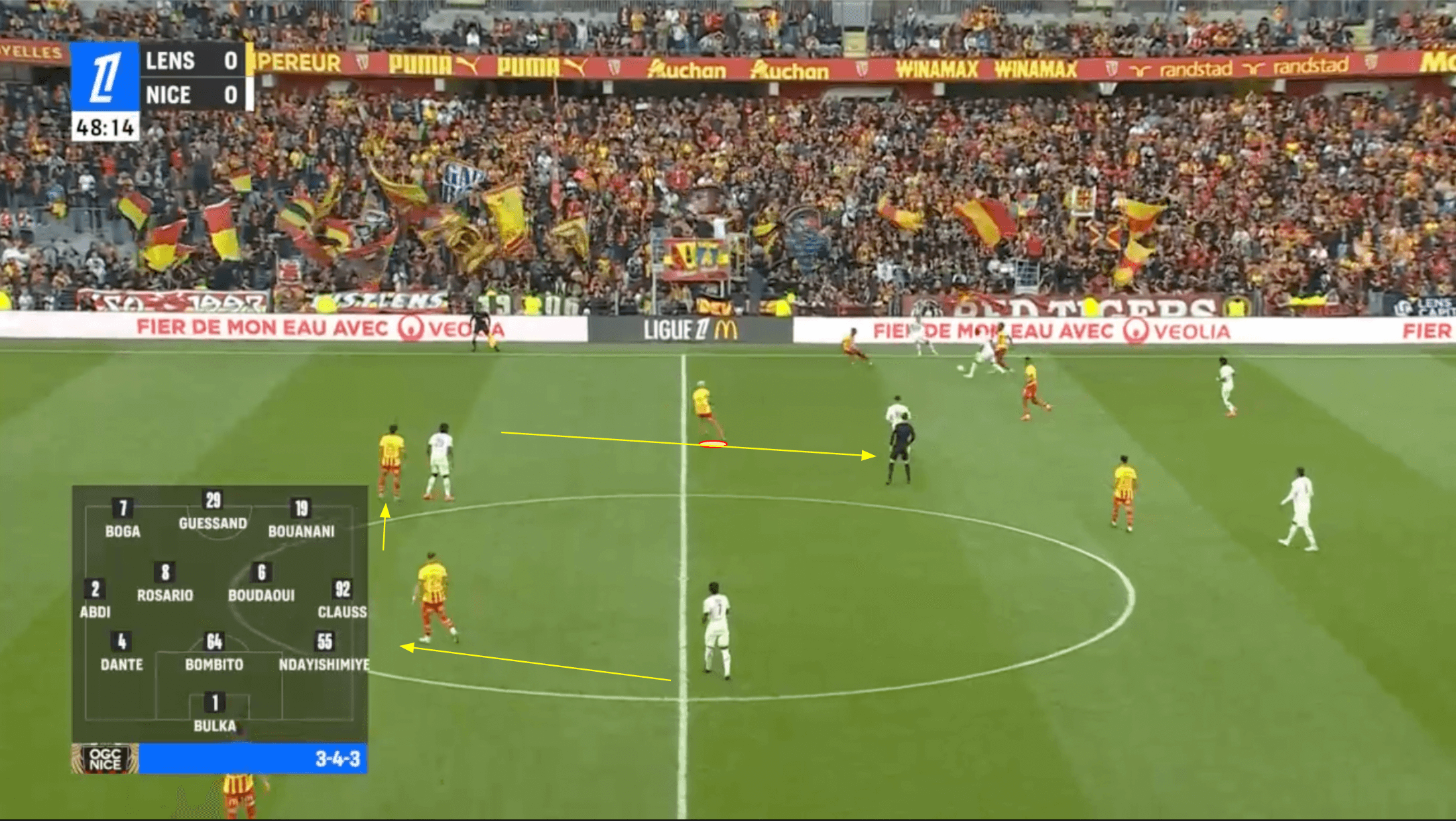
As play moves across to the right, we see Medina reacting to a threat in the half-space behind the midfield, similar to how Gradit reacted previously.
He steps out to get close to that potential receiver, taking the defensive responsibility for that player.
As Medina steps out here, Khusanov shifts over to cover some of the space behind in the left centre-back position while Gradit takes back his right centre-back position.
He moves away from the player he’d been marking before and ensures the backline remains balanced.
As we progress into this analysis, we’ll see more examples of Lens’ centre-backs operating in this fashion.
The key things to remember are that Lens’ centre-backs are often responsible for the space in front of them defensively but will also need very good coordination to cover for one another in the backline.
Lens’ Centre-Back / Central Midfielder Interactions
This next section of analysis will focus on examples of how the roles of Lens’ centre-backs and central midfielders work together to protect their central areas in defensive phases.
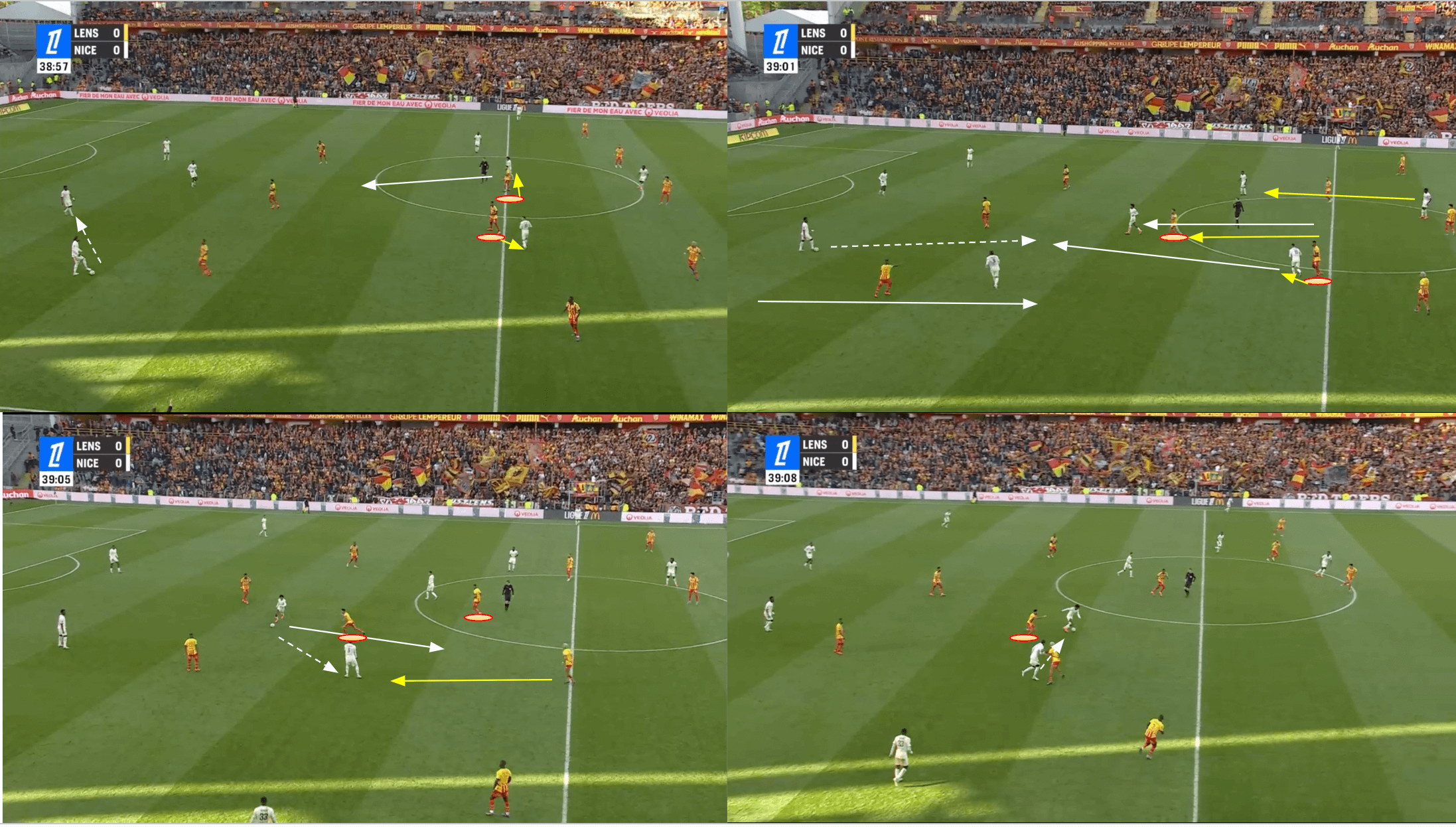
In figure 5, Lens’ central midfielders are circled in all four images, highlighting their man-oriented nature in the middle of the park.
The opponent tried to exploit this man-orientation by rotating another player from the backline into midfield.
This player finds some space just outside the central midfield area, while Lens’ central midfield duo is already occupied with other Nice players.
Step up Facundo Medina, who leaves the backline in the bottom-left image to close down this player as he receives a pass in the half-space.
The Nice man still receives and then returns the pass inside, completing the one-two combination.
Still, the player who receives inside is marked closely by Lens’ central midfielder, who quickly recovers and ends this potential threat.
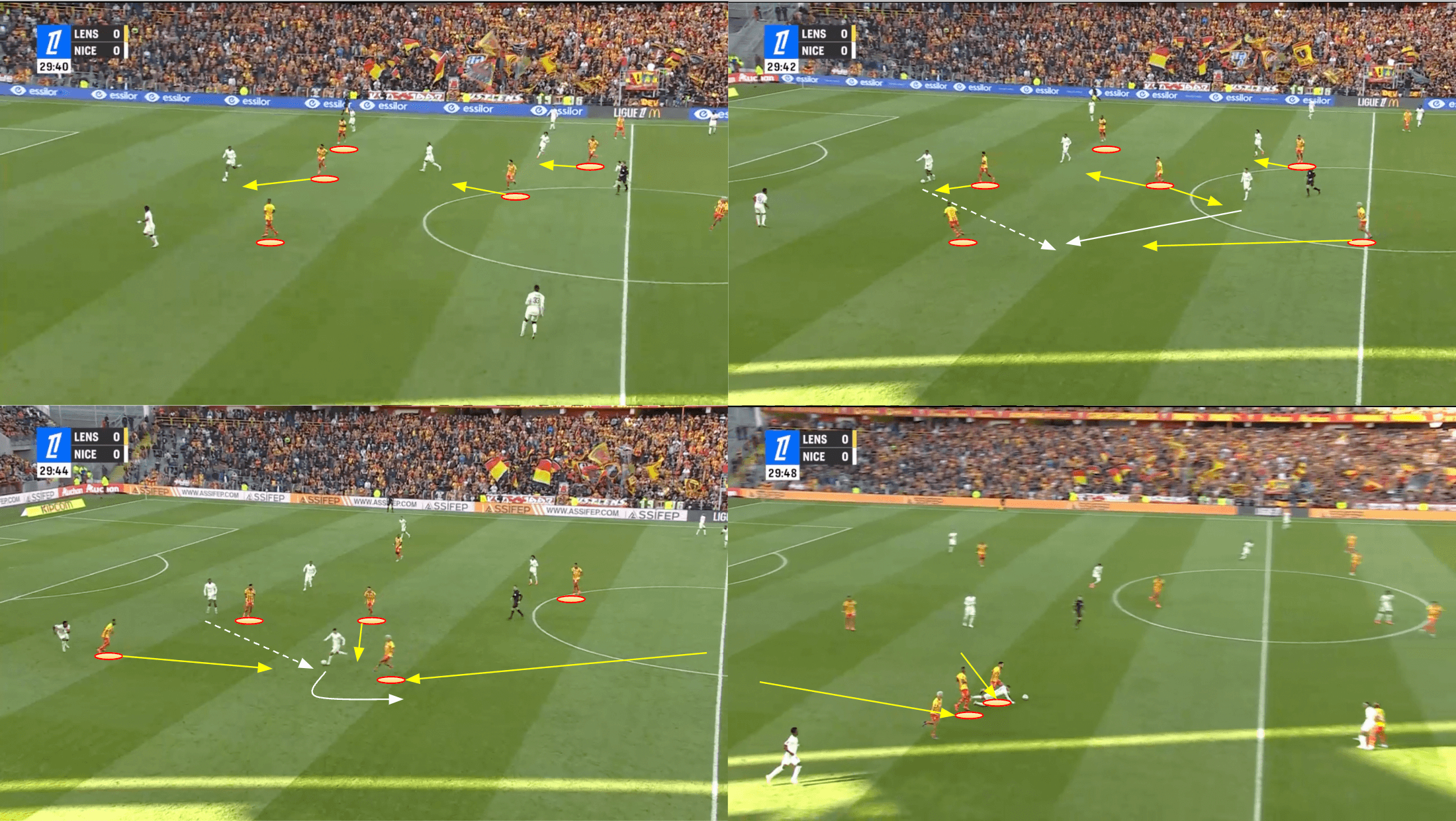
This passage of play shows an example of Medina stepping out to pick up a player drifting across the pitch from zone to zone before ending up in possession in Nice’s right central midfield zone while the two central midfielders are occupied.
This passage of play ends similarly to figure 5, with a central midfielder being able to get across and close down the ball carrier while keeping the player he’d been marking centrally in his cover shadow.
Lens’ right forward also tracked back to effectively apply pressure here, assisting the midfielder in regaining possession.
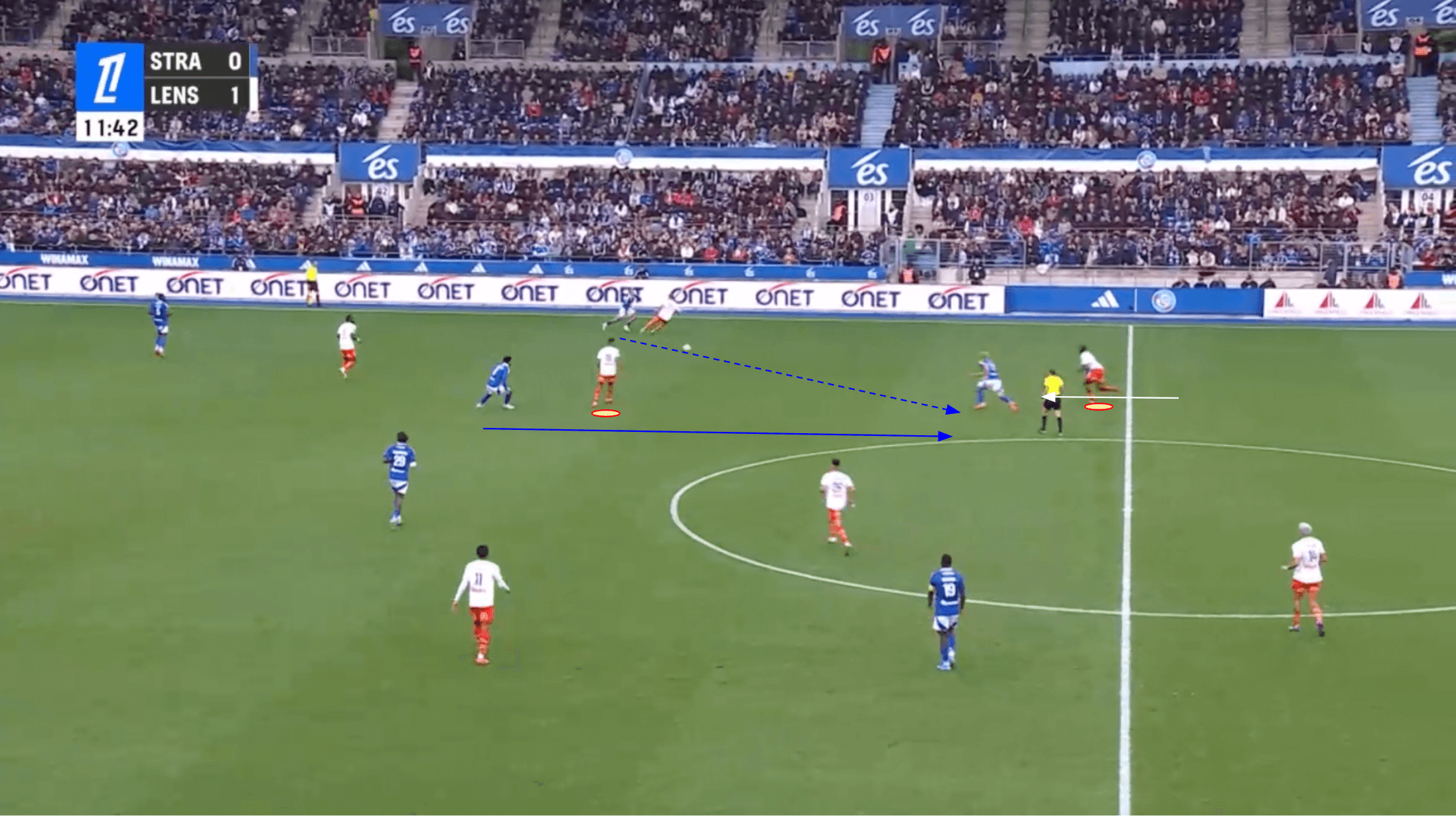
As figure 7 progresses into figure 8 here, notice how the central midfielder highlighted diligently and quickly tracks his man back.
In contrast, Sarr tracks his man forward, leading to the pair essentially exchanging positions.
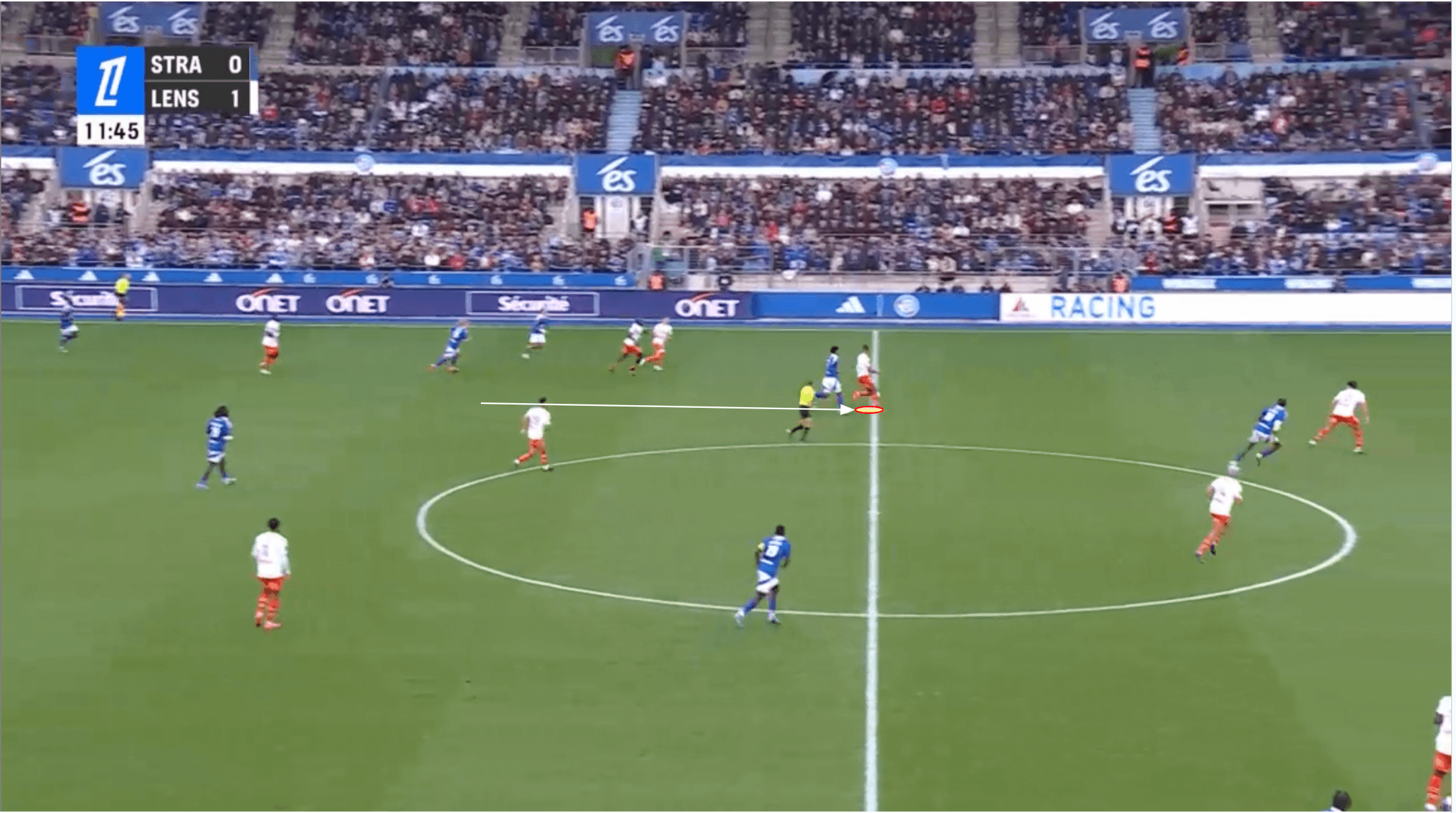
Adrien Thomasson, the right central midfielder, makes a vital interception to prevent the Strasbourg runner from receiving the through pass and exploiting the space opened up by Sarr’s forward movement.
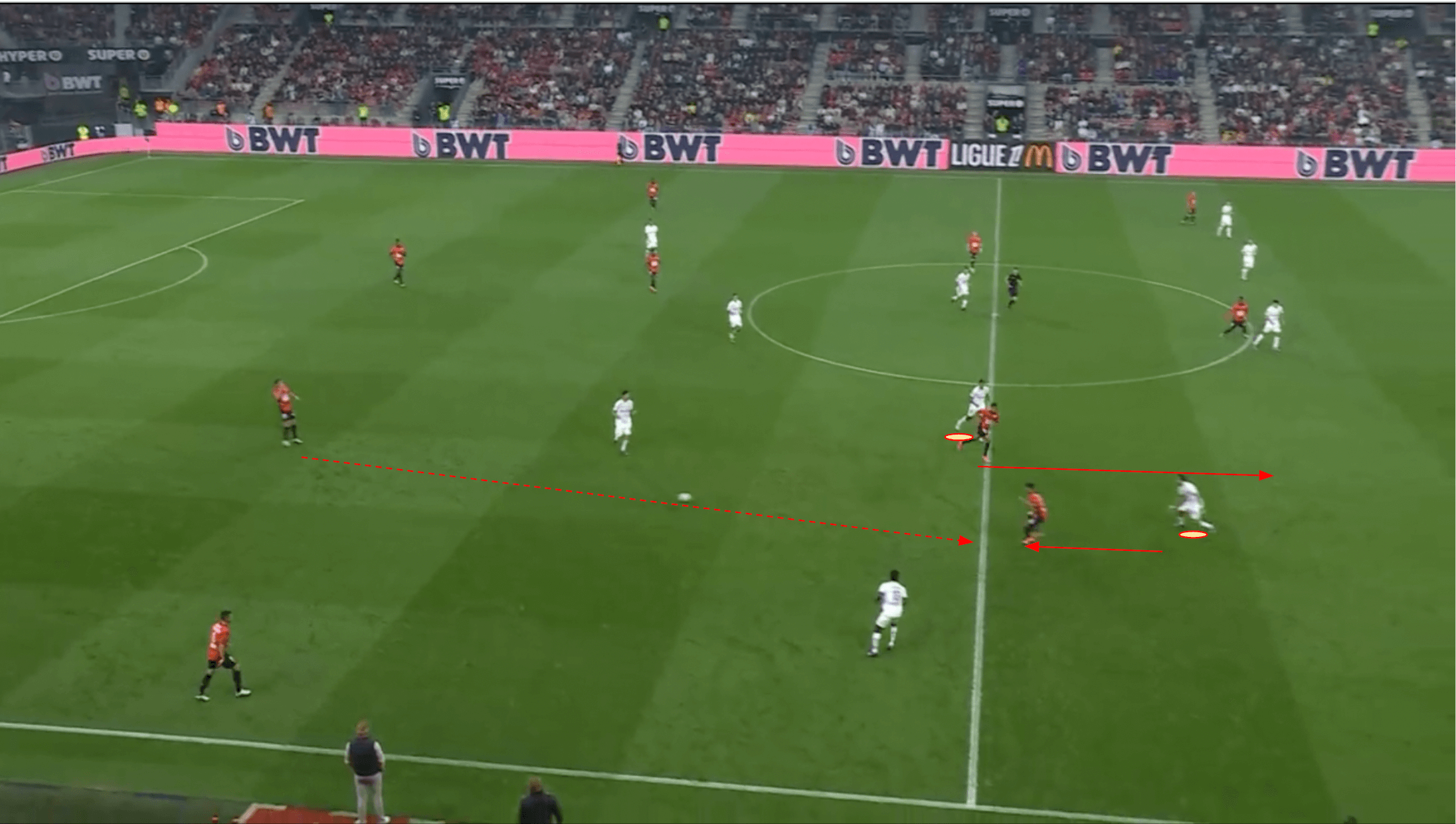
In Figure 9, as Rennes’ right-winger receives to his feet, he attracts attention from the left centre-back, who steps out to try and get tight to him.
Meanwhile, we see a midfielder aiming to run in behind the left centre-back and target the space opening up.
While the runner is being tracked by Lens’ midfielder closely, this could be a way for opponents to exploit Lens and create chances against them from open play as the season progresses and teams get more and more familiar with their defensive tactics.
Quick off-the-ball movement, incisive passing, and fast decision-making will be key for teams looking to exploit the nature of Lens’ defensive system and the gaps they allow to form in their shape.
In this particular case, the receiver wasn’t alert enough to the midfielder’s run and ended up playing a simple pass back to the right-back.
This provides an example of a team failing to capitalise on their intelligent movement to hurt Lens, which has been the case a lot so far this term.
Lens have played their defensive game very well, but they aren’t unbeatable at the back.
However, teams have not done well enough to exploit Les Sang et Or’s aggressive marking in the centre from the wide centre-backs and central midfielders.
Conclusion
To conclude our tactical analysis and scout report, we see that Lens protect their valuable central areas with a combination of man-oriented zonal marking from their central midfield duo in combination with aggressive wide centre-backs being responsible for any space opening up between the lines in their vicinity.
This has worked very well so far this term thanks to the quality of Lens’ players and their familiarity with a three-centre-back system, which was in place throughout Franck Haise’s tenure at the club, and good coaching which has the players knowing exactly what their role is, resulting in the coordination we see on the pitch in Lens’ defence.

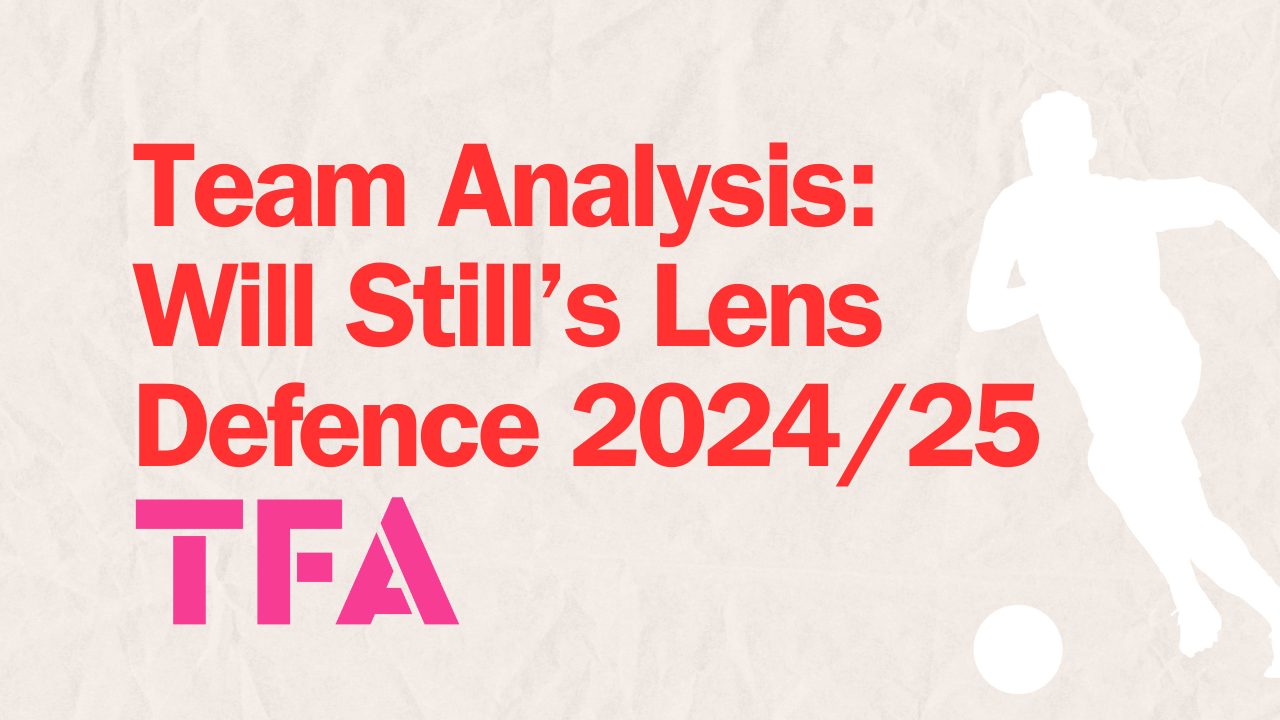



Comments